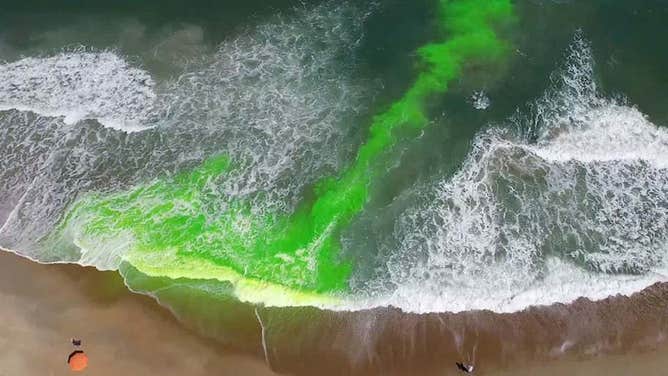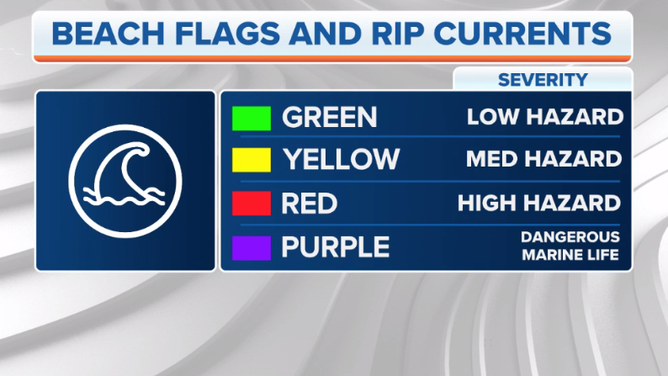How to survive rip currents
Rip currents kill an estimated 100 people a year in the United States
Explaining rip currents and how to stay safe this holiday season
Florida International University Professor Stephen Leatherman explains what a rip current is, and how you can stay safe if you're ever caught in one.
Rip currents are strong, narrow currents that move away from the shore and out to sea at high speed, occurring at any beach that has breaking waves – even the Great Lakes. They can occur on sunny days, when one would believe it’s safe to swim in the ocean.
"Rip currents account for an estimated 100 deaths in the United States each year," said Dr. Gregory Dusek, a physical oceanographer at NOAA who developed the administration’s first-ever national rip current forecast model, which launched in April 2021.
As of Aug. 10, 58 people in the U.S. had already lost their lives to rip currents in 2021, according to NOAA. This is over 11 times greater than the five tornado deaths so far this year. It's also far greater than the six lightning-related fatalities through the end of July.
NOAA AIMS TO KEEP BEACHGOERS SAFE WITH NEW LIFE-SAVING RIP CURRENT FORECAST MODEL
Given how deadly rip currents can be each year, it’s important to understand how to survive if you are unfortunate enough to be caught in one.

This image shows a rip current using a harmless green dye. Rip currents are powerful, narrow channels of fast-moving water that are prevalent along the East, Gulf and West coasts of the U.S., as well as along the shores of the Great Lakes. Moving at speeds of up to 8 feet per second, rip currents can move faster than an Olympic swimmer.
(NOAA/National Ocean Service)
"If you do get caught in a rip current, the best thing you can do is stay calm," Dusek said in NOAA's rip current survival guide. "It's not going to pull you underwater; it's just going to pull you away from shore."
You’re advised to call and wave for help to get the attention of a lifeguard on duty. Do your best to float, and don't swim back toward the shore (against the rip current) because it will just make you tired.
"You want to swim out of the rip, parallel to shore, along the beach, and then follow breaking waves back to shore at an angle," Dusek added.
Dusek advises that you always swim near a lifeguard when at the beach. But if a lifeguard isn’t there, you should be sure to know how to spot a rip current, and if you get caught in one, know how to get out.
"Spotting a rip current can be difficult, and really needs some practice. But when you go to the beach, start off by staying back from the water." Dusek said. "Rip currents are easier to see at an elevated position, like a dune line or beach access, and then look for places where waves aren't breaking, so flat spots in the line of breaking waves. And then also where there's maybe foam or sediment in the water being transported away from the beach offshore."
Always be sure to check beach conditions, including wave forecasts, before your visit. Dusek noted if waves are predicted to be two to three feet or higher, strong rip currents are a possibility. Also, keep in mind that rip currents often occur at low tide.
"People often misunderstand and think that rip currents only occur during bad-weather days at the beach, but actually, you can have strong rip currents with sunny days and waves of only about two to three feet high," Dusek said. "And the reason for that is that rip currents aren't really caused by the weather. They're caused by the waves and other factors, like the tide and the shape of the bottom."
He added that rip currents can occur at any beach that has breaking waves, especially at large sandy beaches along the open ocean. However, they can also occur where hard structures – such as jetties, piers or even rocks – are extending out into the ocean.
"In terms of the tide, usually rip currents are going to occur more at low tide when you have waves breaking over the sandbar near shore," Dusek noted. "Usually you're going to have strong rip currents where you have significant sandbar near the shore with a channel in it."
Many beaches use color-coded flags to warn visitors of the day’s rip current risk.

These color-coded flags are used to warn visitors of the day’s rip current risk.
(FOX Weather)
If you see a green flag, strong rip currents are not expected that day, so you should be able to swim safely. However, beware of the yellow and red flags. A yellow flag means there is a moderate risk of strong rip currents, while a red flag indicates a high risk. Take extreme caution when entering the water if a yellow or red flag is posted on the beach.
You can find NOAA’s official rip current forecasts at this link.
